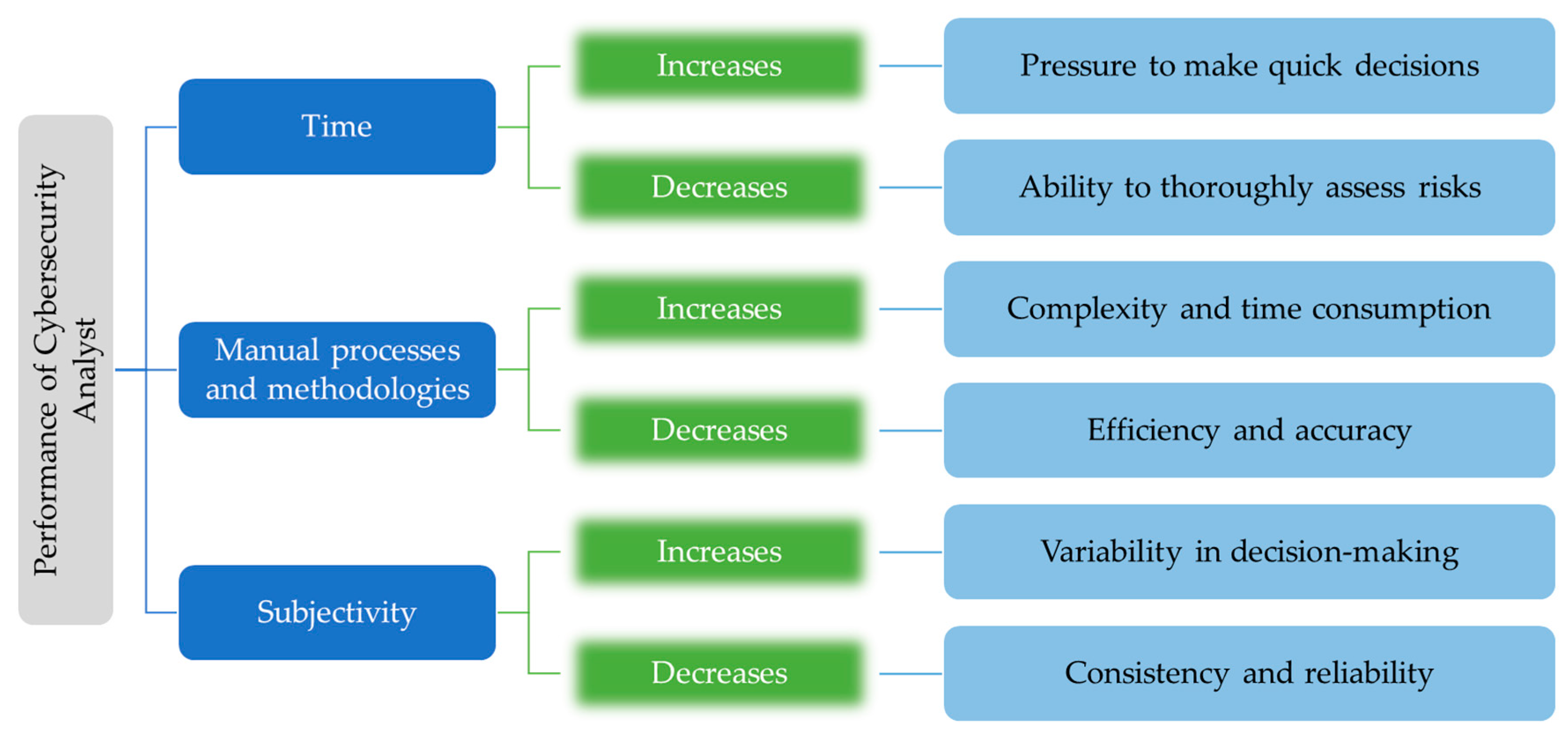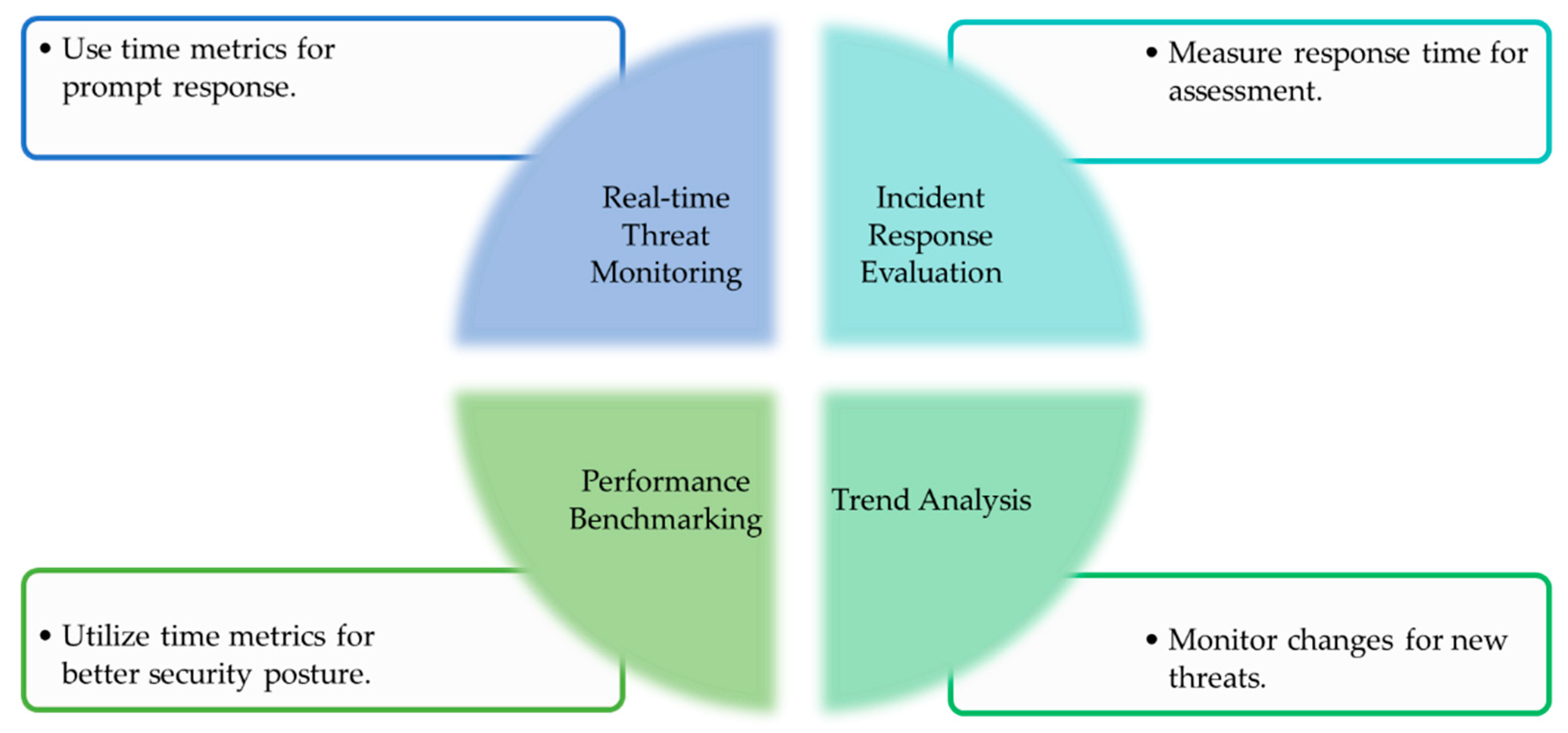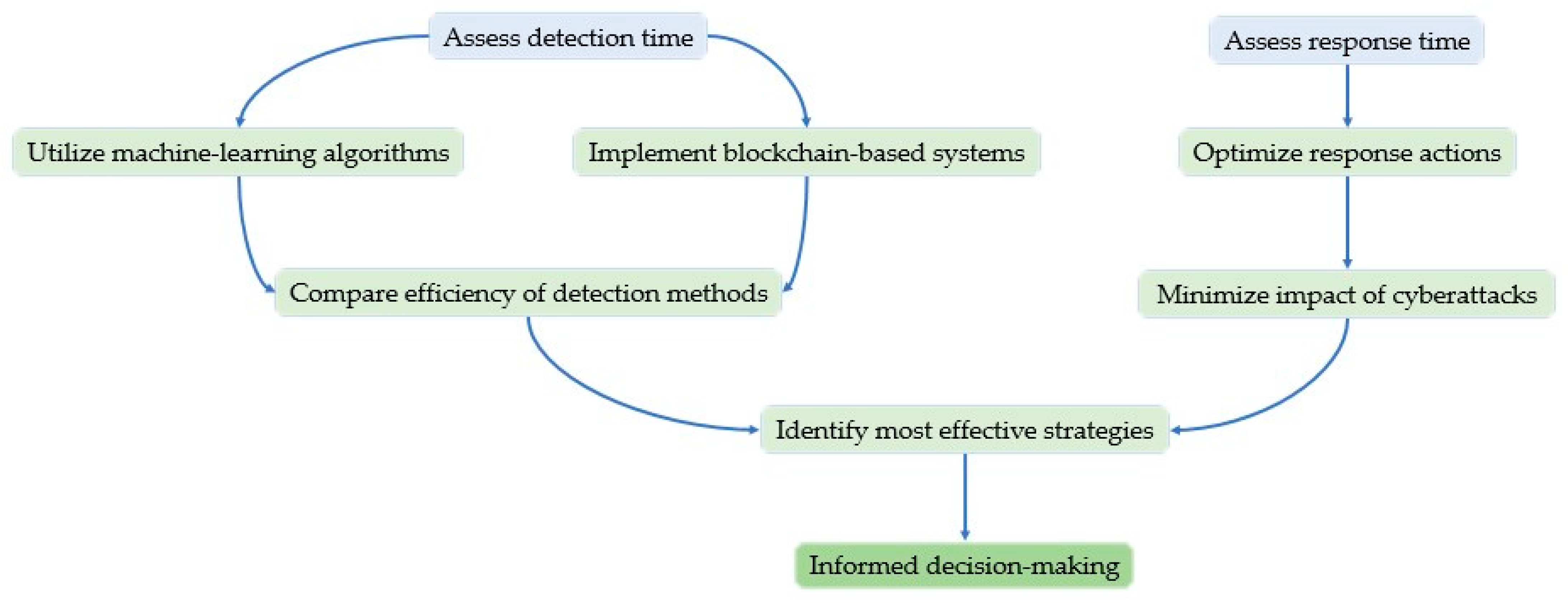Insights into Cybercrime Detection and Response: A Review of Time Factor
Abstract
:1. Introduction
2. Concepts
- Organizations may monitor cyber threats in real-time using time-related metrics, which enables timely security-event identification and response [22];
- Response time metrics offer useful insights into how rapidly companies can detect and address security breaches, which aids in assessing the effectiveness of incident-response procedures [22];
- Time-related metrics help detect new threats and vulnerabilities by monitoring changes in security events, vulnerabilities, and attack behaviors over time [23];
- These indicators let firms evaluate cybersecurity by comparing their performance to industry standards and best practices [24].
3. Methodology
3.1. Data Sources and Analysis Methods
3.2. Limitations of the Study
4. Results and Findings
4.1. Detection
4.2. Response
5. Discussion
6. Conclusions and Future Work
Funding
Institutional Review Board Statement
Data Availability Statement
Conflicts of Interest
References
- Bogatinov, D.S.; Bogdanoski, M.; Angelevski, S. AI-based cyber defense for more secure cyberspace. In Handbook of Research on Civil Society and National Security in the Era of Cyber Warfare; IGI Global: Hershey, PA, USA, 2016; pp. 220–237. [Google Scholar]
- Rodrigues, D.; de Rosa, G.H.; Passos, L.A.; Papa, J.P. Adaptive improved flower pollination algorithm for global optimization. In Nature-Inspired Computation in Data Mining and Machine Learning; Springer: Cham, Switzerland, 2020; pp. 1–21. [Google Scholar]
- Morgan, G.; Gordijn, B. A care-based stakeholder approach to ethics of cybersecurity in business. Ethics Cybersecur. 2020, 21, 119–138. [Google Scholar]
- Winterrose, M.L.; Carter, K.M.; Wagner, N.; Streilein, W.W. Adaptive attacker strategy development against moving target cyber defenses. In Advances in Cyber Security Analytics and Decision Systems; Springer: Cham, Switzerland, 2020; pp. 1–14. [Google Scholar]
- Maalem Lahcen, R.A.; Caulkins, B.; Mohapatra, R.; Kumar, M. Review and insight on the behavioral aspects of cybersecurity. Cybersecurity 2020, 3, 10. [Google Scholar] [CrossRef]
- Taherdoost, H.; Madanchian, M.; Ebrahimi, M. Advancement of Cybersecurity and Information Security Awareness to Facilitate Digital Transformation: Opportunities and Challenges. In Handbook of Research on Advancing Cybersecurity for Digital Transformation; IGI Global: Hershey, PA, USA, 2021; pp. 99–117. [Google Scholar]
- Cremer, F.; Sheehan, B.; Fortmann, M.; Kia, A.N.; Mullins, M.; Murphy, F.; Materne, S. Cyber risk and cybersecurity: A systematic review of data availability. Geneva Pap. Risk Insur.-Issues Pract. 2022, 47, 698–736. [Google Scholar] [CrossRef]
- Riesco, R.; Larriva-Novo, X.; Villagrá, V.A. Cybersecurity threat intelligence knowledge exchange based on blockchain: Proposal of a new incentive model based on blockchain and Smart contracts to foster the cyber threat and risk intelligence exchange of information. Telecommun. Syst. 2020, 73, 259–288. [Google Scholar] [CrossRef]
- Rana, M.U.; Ellahi, O.; Alam, M.; Webber, J.L.; Mehbodniya, A.; Khan, S. Offensive security: Cyber threat intelligence enrichment with counterintelligence and counterattack. IEEE Access 2022, 10, 108760–108774. [Google Scholar] [CrossRef]
- Ayala, C.; Jiménez, K.; Loza-Aguirre, E.; Andrade, R.O. A Hybrid Recommender for Cybersecurity Based on Rating Approach. In Advances in Cybersecurity Management; Springer: Berlin/Heidelberg, Germany, 2021; pp. 445–462. [Google Scholar]
- Veena, K.; Meena, K.; Kuppusamy, R.; Teekaraman, Y.; Angadi, R.V.; Thelkar, A.R. Cybercrime: Identification and prediction using machine learning techniques. Comput. Intell. Neurosci. 2022, 2022, 8237421. [Google Scholar] [CrossRef] [PubMed]
- Ramakrishnan, S.; Senthil Rajan, A. Network attack detection with QNNBADT in minimal response times using minimized features. In Computer Networks and Inventive Communication Technologies; Lecture Notes on Data Engineering and Communications Technologies; Springer: Singapore, 2022; pp. 563–579. [Google Scholar]
- Taherdoost, H. Security and internet of things: Benefits, challenges, and future perspectives. Electronics 2023, 12, 1901. [Google Scholar] [CrossRef]
- Chinedu, P.U.; Nwankwo, W.; Masajuwa, F.U.; Imoisi, S. Cybercrime Detection and Prevention Efforts in the Last Decade: An Overview of the Possibilities of Machine Learning Models. Rev. Int. Geogr. Educ. Online 2021, 11, 956–974. [Google Scholar]
- Sarre, R.; Lau, L.Y.-C.; Chang, L.Y. Responding to cybercrime: Current trends. Police Pract. Res. 2018, 19, 515–518. [Google Scholar] [CrossRef]
- Azzedin, F.; Suwad, H.; Rahman, M.M. An Asset-Based Approach to Mitigate Zero-Day Ransomware Attacks. Comput. Mater. Contin. 2022, 73, 3003–3020. [Google Scholar] [CrossRef]
- Biswas, B.; Mukhopadhyay, A.; Kumar, A.; Delen, D. A hybrid framework using explainable AI (XAI) in cyber-risk management for defence and recovery against phishing attacks. Decis. Support Syst. 2024, 177, 114102. [Google Scholar] [CrossRef]
- Bafna, E. Real Time Cloud Based Intrusion Detection. In Deep Learning Approaches to Cloud Security; Wiley: Hoboken, NJ, USA, 2022; pp. 207–224. [Google Scholar]
- Khraisat, A.; Alazab, A. A critical review of intrusion detection systems in the internet of things: Techniques, deployment strategy, validation strategy, attacks, public datasets and challenges. Cybersecurity 2021, 4, 18. [Google Scholar] [CrossRef]
- Khraisat, A.; Gondal, I.; Vamplew, P.; Kamruzzaman, J. Survey of intrusion detection systems: Techniques, datasets and challenges. Cybersecurity 2019, 2, 20. [Google Scholar] [CrossRef]
- Maleh, Y.; Alazab, M.; Tawalbeh, L.; Romdhani, I. Big Data Analytics and Intelligent Systems for Cyber Threat Intelligence; CRC Press: Boca Raton, FL, USA, 2023. [Google Scholar]
- Pendleton, M.; Garcia-Lebron, R.; Cho, J.-H.; Xu, S. A survey on systems security metrics. ACM Comput. Surv. (CSUR) 2016, 49, 62. [Google Scholar] [CrossRef]
- Li, Y.; Liu, Q. A comprehensive review study of cyber-attacks and cyber security; Emerging trends and recent developments. Energy Rep. 2021, 7, 8176–8186. [Google Scholar] [CrossRef]
- Chaudhary, S.; Gkioulos, V.; Katsikas, S. Developing metrics to assess the effectiveness of cybersecurity awareness program. J. Cybersecur. 2022, 8, tyac006. [Google Scholar] [CrossRef]
- Ait Maalem Lahcen, R.; Mohapatra, R.; Kumar, M. Cybersecurity: A survey of vulnerability analysis and attack graphs. In Mathematics and Computing: ICMC 2018, Varanasi, India, 9–11 January 2018; Selected Contributions 4; Springer: Singapore, 2018; pp. 97–111. [Google Scholar]
- Dodge, C.; Burruss, G. Policing cybercrime: Responding to the growing problem and considering future solutions. In The Human Factor of Cybercrime; Routledge: London, UK, 2019; pp. 339–358. [Google Scholar]
- UK HMIC. Real Lives, Real Crimes: A Study of Digital Crime and Policing; HMIC: London, UK, 2015.
- Guedes, I.; Martins, M.; Cardoso, C.S. Exploring the determinants of victimization and fear of online identity theft: An empirical study. Secur. J. 2023, 36, 472–497. [Google Scholar] [CrossRef]
- Abu-Ulbeh, W.; Altalhi, M.; Abualigah, L.; Almazroi, A.A.; Sumari, P.; Gandomi, A.H. Cyberstalking victimization model using criminological theory: A systematic literature review, taxonomies, applications, tools, and validations. Electronics 2021, 10, 1670. [Google Scholar] [CrossRef]
- Marttila, E.; Koivula, A.; Räsänen, P. Cybercrime victimization and problematic social media use: Findings from a nationally representative panel study. Am. J. Crim. Justice 2021, 46, 862–881. [Google Scholar] [CrossRef]
- Miró-Llinares, F.; Moneva, A. Environmental criminology and cybercrime: Shifting focus from the wine to the bottles. In The Palgrave Handbook of International Cybercrime and Cyberdeviance; Springer: Berlin/Heidelberg, Germany, 2020; pp. 491–511. [Google Scholar]
- Cost of a Cyber Incident: Systematic Review and Cross-Validation; Cybersecurity & Infrastructure Security Agency: Washington, DC, USA, 2021.
- Robalo, T.L.A.; Abdul Rahim, R.B.B. Cyber victimisation, restorative justice and victim-offender panels. Asian J. Criminol. 2023, 18, 61–74. [Google Scholar] [CrossRef]
- Jansen, J.; Leukfeldt, R. Coping with cybercrime victimization: An exploratory study into impact and change. J. Qual. Crim. Justice Criminol. 2018, 6, 205–228. [Google Scholar]
- Safitra, M.F.; Lubis, M.; Fakhrurroja, H. Counterattacking cyber threats: A framework for the future of cybersecurity. Sustainability 2023, 15, 13369. [Google Scholar] [CrossRef]
- Nugroho, A.; Chandrawulan, A.A. Research synthesis of cybercrime laws and COVID-19 in Indonesia: Lessons for developed and developing countries. Secur. J. 2023, 36, 651–670. [Google Scholar] [CrossRef]
- Abdullahi, M.; Baashar, Y.; Alhussian, H.; Alwadain, A.; Aziz, N.; Capretz, L.F.; Abdulkadir, S.J. Detecting cybersecurity attacks in internet of things using artificial intelligence methods: A systematic literature review. Electronics 2022, 11, 198. [Google Scholar] [CrossRef]
- Gong, S.; Lee, C. Cyber threat intelligence framework for incident response in an energy cloud platform. Electronics 2021, 10, 239. [Google Scholar] [CrossRef]
- Afzaliseresht, N.; Miao, Y.; Michalska, S.; Liu, Q.; Wang, H. From logs to stories: Human-centred data mining for cyber threat intelligence. IEEE Access 2020, 8, 19089–19099. [Google Scholar] [CrossRef]
- Adebowale, M.A.; Lwin, K.T.; Hossain, M.A. Intelligent phishing detection scheme using deep learning algorithms. J. Enterp. Inf. Manag. 2020, 36, 747–766. [Google Scholar] [CrossRef]
- Ariyadasa, S.; Fernando, S.; Fernando, S. Combining long-term recurrent convolutional and graph convolutional networks to detect phishing sites using URL and HTML. IEEE Access 2022, 10, 82355–82375. [Google Scholar] [CrossRef]
- de Araujo-Filho, P.F.; Naili, M.; Kaddoum, G.; Fapi, E.T.; Zhu, Z. Unsupervised gan-based intrusion detection system using temporal convolutional networks and self-attention. IEEE Trans. Netw. Serv. Manag. 2023, 20, 4951–4963. [Google Scholar] [CrossRef]
- Maosa, H.; Ouazzane, K.; Sowinski-Mydlarz, V. Real-time cyber analytics data collection framework. Int. J. Inf. Secur. Priv. (IJISP) 2022, 16, 1–10. [Google Scholar] [CrossRef]
- Al-Haija, Q.A. Cost-effective detection system of cross-site scripting attacks using hybrid learning approach. Results Eng. 2023, 19, 101266. [Google Scholar] [CrossRef]
- Sherubha, P.; Mohanasundaram, N. An efficient network threat detection and classification method using ANP-MVPS algorithm in wireless sensor networks. Int. J. Innov. Technol. Explor. Eng. 2019, 8, 1597–1606. [Google Scholar] [CrossRef]
- Naeem, M.R.; Khan, M.; Abdullah, A.M.; Noor, F.; Khan, M.I.; Khan, M.A.; Ullah, I.; Room, S. A malware detection scheme via smart memory forensics for windows devices. Mob. Inf. Syst. 2022, 2022, 9156514. [Google Scholar] [CrossRef]
- Tolba, A.; Al-Makhadmeh, Z. A cybersecurity user authentication approach for securing smart grid communications. Sustain. Energy Technol. Assess. 2021, 46, 101284. [Google Scholar] [CrossRef]
- Chen, T.; Yin, X.; Wang, G. Securing communications between smart grids and real users; providing a methodology based on user authentication. Energy Rep. 2021, 7, 8042–8050. [Google Scholar] [CrossRef]
- De Araujo-Filho, P.F.; Pinheiro, A.J.; Kaddoum, G.; Campelo, D.R.; Soares, F.L. An efficient intrusion prevention system for CAN: Hindering cyber-attacks with a low-cost platform. IEEE Access 2021, 9, 166855–166869. [Google Scholar] [CrossRef]
- Yang, Y.; Xie, G.; Wang, J.; Zhou, J.; Xia, Z.; Li, R. Intrusion detection for in-vehicle network by using single GAN in connected vehicles. J. Circuits Syst. Comput. 2021, 30, 2150007. [Google Scholar] [CrossRef]
- Ilango, H.S.; Ma, M.; Su, R. A feedforward–convolutional neural network to detect low-rate dos in iot. Eng. Appl. Artif. Intell. 2022, 114, 105059. [Google Scholar] [CrossRef]
- Ingle, D.; Ingle, D. An enhanced blockchain based security and attack detection using transformer in iot-cloud network. J. Adv. Res. Appl. Sci. Eng. Technol. 2023, 31, 142–156. [Google Scholar]
- Altamimi, A.B.; Ahmed, M.; Khan, W.; Alsaffar, M.; Ahmad, A.; Khan, Z.H.; Alreshidi, A. PhishCatcher: Client-Side Defense against Web Spoofing Attacks Using Machine Learning. IEEE Access 2023, 11, 61249–61263. [Google Scholar]
- Prabakaran, M.K.; Meenakshi Sundaram, P.; Chandrasekar, A.D. An enhanced deep learning-based phishing detection mechanism to effectively identify malicious URLs using variational autoencoders. IET Inf. Secur. 2023, 17, 423–440. [Google Scholar] [CrossRef]
- Shukla, S.; Misra, M.; Varshney, G. HTTP header based phishing attack detection using machine learning. Trans. Emerg. Telecommun. Technol. 2024, 35, e4872. [Google Scholar] [CrossRef]
- Ariyadasa, S.; Fernando, S.; Fernando, S. SmartiPhish: A reinforcement learning-based intelligent anti-phishing solution to detect spoofed website attacks. Int. J. Inf. Secur. 2024, 23, 1055–1076. [Google Scholar] [CrossRef]
- Basuki, A.; Adriansyah, A. Response time optimization for vulnerability management system by combining the benchmarking and scenario planning models. Int. J. Electr. Comput. Eng. 2023, 13, 561–570. [Google Scholar] [CrossRef]
- Soundararajan, S.; Nithya, B.; Nithya, N.; Vignesh, T. Block chain espoused adaptive multi-scale dual attention network with quaternion fractional order meixner moments encryption for cyber security in wireless communication network. Wirel. Netw. 2024, 1–17. [Google Scholar] [CrossRef]
- Choi, S.-H.; Youn, J.; Kim, K.; Lee, S.; Kwon, O.-J.; Shin, D. Cyber-Resilience Evaluation Methods Focusing on Response Time to Cyber Infringement. Sustainability 2023, 15, 13404. [Google Scholar] [CrossRef]
- Vasylyshyn, S.; Susukailo, V.; Opirskyy, I.; Kurii, Y.; Tyshyk, I. A model of decoy system based on dynamic attributes for cybercrime investigation. East.-Eur. J. Enterp. Technol. 2023, 1, 121. [Google Scholar]
- Lee, W.-K.; Jang, K.; Song, G.; Kim, H.; Hwang, S.O.; Seo, H. Efficient implementation of lightweight hash functions on GPU and quantum computers for IoT applications. IEEE Access 2022, 10, 59661–59674. [Google Scholar] [CrossRef]
- Benlloch-Caballero, P.; Wang, Q.; Calero, J.M.A. Distributed dual-layer autonomous closed loops for self-protection of 5G/6G IoT networks from distributed denial of service attacks. Comput. Netw. 2023, 222, 109526. [Google Scholar] [CrossRef]
- Pourvahab, M.; Ekbatanifard, G. Digital forensics architecture for evidence collection and provenance preservation in iaas cloud environment using sdn and blockchain technology. IEEE Access 2019, 7, 153349–153364. [Google Scholar] [CrossRef]
- Nasir, M.H.; Arshad, J.; Khan, M.M. Collaborative device-level botnet detection for internet of things. Comput. Secur. 2023, 129, 103172. [Google Scholar] [CrossRef]
- Razaque, A.; Yoo, J.; Bektemyssova, G.; Alshammari, M.; Chinibayeva, T.T.; Amanzholova, S.; Alotaibi, A.; Umutkulov, D. Efficient Internet-of-Things Cyberattack Depletion Using Blockchain-Enabled Software-Defined Networking and 6G Network Technology. Sensors 2023, 23, 9690. [Google Scholar] [CrossRef] [PubMed]
- Li, J.; Lyu, L.; Liu, X.; Zhang, X.; Lyu, X. FLEAM: A federated learning empowered architecture to mitigate DDoS in industrial IoT. IEEE Trans. Ind. Inform. 2021, 18, 4059–4068. [Google Scholar] [CrossRef]




| Research Objectives | Research Questions |
|---|---|
| To examine the importance of time-related metrics, specifically detection time and response time | What is the significance of detection time and response time in the context of cybercrime detection and response? |
| To identify and analyze the factors influencing detection time and response time in cyber-defense operations | What factors influence detection time and response time in cyber-defense operations? |
| To explore existing frameworks and models for measuring and evaluating time-related metrics. | What frameworks and models are available for measuring and evaluating time-related metrics in cybercrime detection and response? |
| Study | Detection Method | Detection Time (s) | Change in Detection Time |
|---|---|---|---|
| Ariyadasa et al. [41] | PhishDet using Long-term Recurrent Convolutional Network | 1.8 | - |
| Adebowale et al. [40] | Intelligent Phishing Detection System (IPDS) | 25 | Increase |
| Tolba and Al-Makhadmeh [47] | Cybersecurity-assisted authentication for smart grids | 4.67 | Decrease |
| Chen et al. [48] | Two-way authentication for smart grids | Variable | Increase (1.4 s) |
| Sherubha and Mohanasundaram [45] | Naive Bayes classifier with a trust value | 27.35 | - |
| Al-Haija [44] | Machine-learning-based XSS detection system | 1.031 × 10−4 | - |
| Naeem et al. [46] | Smart memory forensics system | 73 times | Increase |
| de Araujo-Filho et al. [49] | Unsupervised intrusion prevention system (IPS) for CANs | <80 × 10−6 | Decrease |
| Ilango et al. [51] | FeedForward–Convolutional Neural Network (FFCNN) | 3.87 × 10−6 | - |
| Yang et al. [50] | Enhanced GAN-based IDS | 0.12 ± 0.03 | Decrease |
| Maosa et al. [43] | Framework for data gathering | 300 | Decrease |
| Ingle and Ingle [52] | BC-Trans Network | 225.3 | - |
| Study | Proposed Methodology | Response Time Metrics |
|---|---|---|
| Prabakaran et al. [54] | Deep-learning-based phishing detection using DNN and VAE | 1.9 s |
| Shukla et al. [55] | Machine-learning-based anti-phishing detection using HTTP headers | 1.57 s |
| Ariyadasa et al. [56] | SmartiPhish: Anti-phishing solution with continuous learning | 4.3 s |
| Altamimi et al. [53] | PhishCatcher: Client-side defense mechanism using machine learning | 62.5 × 10−3 s |
| Basuki and Adriansyah [57] | Vulnerability management system with scenario planning and benchmarking | <6 s |
| Soundararajan et al. [58] | BC-CS-AMSDAN-QFOMM-WCN: Adaptive multi-scale dual attention network with Quaternion fractional order Meixner moments | 36.51%, 13.09%, and 22.24% minimum delay |
| Vasylyshyn et al. [60] | Blockchain-based decoy system for detecting cybercrime | At 2 Mbps, a DDoS assault impacts response time, with dynamic hosts consistently faster than static hosts between 2 and 4 Mbps. |
| Lee et al. [61] | Optimization of lightweight hash functions for high-performance data integrity tests | Ranged from 70 Gbps to 1000 Gbps |
| Benlloch-Caballero et al. [62] | Cognitive closed-loop system for self-protection against DDoS attacks | 18 s |
| Pourvahab and Ekbatanifard [63] | Digital forensic architecture for IaaS clouds using Blockchain and SDN | 75 × 10−3 s |
| Nasir et al. [64] | BTC_SIGBDS: Blockchain-powered, Trustworthy, Collaborative, Signature-based Botnet Detection System | 298.5 s |
| Razaque et al. [65] | Virtual network function software-defined networking (VNFSDN) | 0.08 × 10−3 s |
| Li et al. [66] | Federated learning for harmful coding detection using fog/edge computing | 72% shorter |
Disclaimer/Publisher’s Note: The statements, opinions and data contained in all publications are solely those of the individual author(s) and contributor(s) and not of MDPI and/or the editor(s). MDPI and/or the editor(s) disclaim responsibility for any injury to people or property resulting from any ideas, methods, instructions or products referred to in the content. |
© 2024 by the author. Licensee MDPI, Basel, Switzerland. This article is an open access article distributed under the terms and conditions of the Creative Commons Attribution (CC BY) license (https://creativecommons.org/licenses/by/4.0/).
Share and Cite
Taherdoost, H. Insights into Cybercrime Detection and Response: A Review of Time Factor. Information 2024, 15, 273. https://doi.org/10.3390/info15050273
Taherdoost H. Insights into Cybercrime Detection and Response: A Review of Time Factor. Information. 2024; 15(5):273. https://doi.org/10.3390/info15050273
Chicago/Turabian StyleTaherdoost, Hamed. 2024. "Insights into Cybercrime Detection and Response: A Review of Time Factor" Information 15, no. 5: 273. https://doi.org/10.3390/info15050273
APA StyleTaherdoost, H. (2024). Insights into Cybercrime Detection and Response: A Review of Time Factor. Information, 15(5), 273. https://doi.org/10.3390/info15050273









